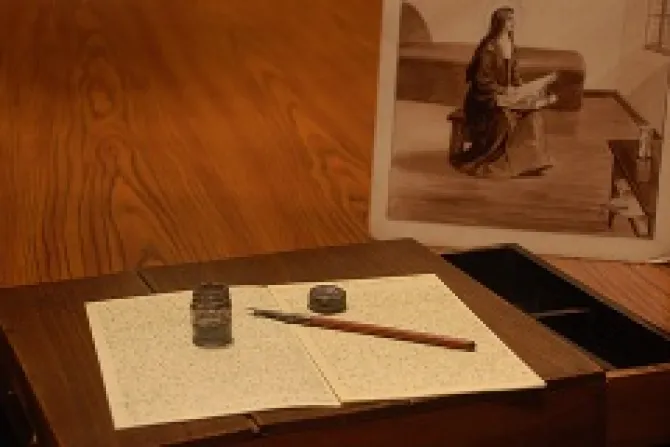Washington, D.C., Oct 5, 2013 / 14:03 pm
As a weathered wooden writing desk tours the U.S., its drawers stained black with century-old ink, its presence helps bring the faithful closer to the saint who used it to pen "Story of a Soul" – Thérèse of Lisieux.
The relics, which also include a wooden pen and a small glass ink well, are a "very human and very intimate remembrance of the Little Flower," said Father Andrew Small, OMI, director of the Pontifical Mission Societies in the United States.
The tour of the writing instruments that the saint used in the last years of her life have served both as a means of teaching the faithful about St. Thérèse and as a way for the faithful to share their stories of the impact she has made in their lives.
People "just identify with her," Fr. Small told CNA Oct. 3, adding that many coming to see the relics spoke about the comfort and friendship St. Thérèse provides "when people are most distraught."
"This is a way we get closer to Thérèse, whom we know is close to God," the priest said of the artifacts.
St. Thérèse of Lisieux, whom Pope Pius X in the early 20th century called "the greatest saint of modern times," lived a quiet life, speaking in her spiritual autobiography of her desire "to be unknown." She died of tuberculosis at the age of 24 on Sept. 30, 1897 in the Carmelite convent of Lisieux, France, which she had never left after entering at the age of 15.
However, through her writings to missionaries and the distribution of her spiritual autobiography "Story of a Soul," St. Thérèse's "Little Way" of doing small things with great love has been an inspiration to Catholics around the world and made her the patron saint of missionaries.
The pen, ink well and lap desk that St. Thérèse used for the last three years of her life to write letters, prayers, poems, and her memoirs, including parts of her spiritual autobiography, were last used Sept. 8, 1897.
They are currently on loan to the Pontifical Mission Societies in the United States, visiting over 20 dioceses in the U.S. and leaving the Carmelite convent in France for the first time since the convent was founded. They will next be in St. Louis, Mo., Oct. 5-6.
St. Thérèse "knew that the way to purify herself and her faith was uniting herself with Christ in every moment of every day," Fr. Small explained.
"Her 'Little Way' is to see every second of every minute of every hour as a moment when we can encounter Christ, most especially during the times of triumph and suffering and seeming despair," he continued.
"It's not easy to see the world this way – it's the narrow gate that we hear about in the Gospel, or the Little Way that we read about in the Story of a Soul."
This approach has drawn many close to the saint, Fr. Small said, adding that while touring the country with the relics, he has heard countless stories of the example St. Thérèse has shown people in some of the most difficult times of their lives, that "nothing could separate us from the love of Christ."
"It's almost overwhelming how Thérèse is accredited with accompanying people in the most terrible and awful moments of their lives."
The artifacts have "very much personalized her in everyday life," serving as a link to her life, Fr. Small continued, adding that they are "this incredible way of uniting people to the cell where she lived and died."
"They feel already so very close with Thérèse, and this brings them even closer."
"It's very personal," Fr. Small stated, and "it's that proximity that makes people feel very loved."
Fr. Small said that those who wish to leave intentions for St. Thérèse are given cards with her shield on one side. They can write their intentions on the cards, which are then placed next to the desk, and will be placed on the saint's grave when St. Thérèse's artifacts return to Lisieux.
Despite the saint's "too-good-to-be-true" story, and her focus on love, meekness and childlike dependence upon God, Thérèse's life and approach to spirituality can be an inspiration in difficult times, especially for youth of today's world, Fr. Small explained.
"She had no sense, even in the darkness of her later years, that she was alone," he stated, and her life demonstrated that "faith is not a fruitless or useless human exercise."
"There's nothing unreal or surreal about the Story of a Soul: it's the story of every soul."



